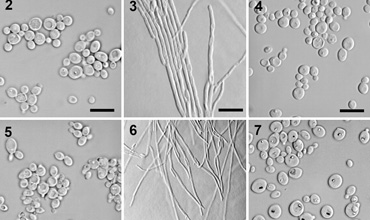The Biofilm Production by Various Candida Species Isolated from Different Clinical Samples

Abstract:
Pathogenic fungi in the genus Candida can cause both
superficial and serious systemic disease, and are now recognized as major
agents of hospital-acquired infection.
Candida infections involve the formation of biofilms
on implanted devices such as indwelling catheters or prosthetic heart valves.
Nosocomial infections due to candida are also becoming increasingly important. Early and prompt diagnosis, proper treatment and
prevention of candidemia due to biofilms pose a major challenge for
microbiologists and clinicians worldwide. Biofilm is an aggregate of
microorganism in which cell adhere to each other on a surface. It has been
reported that organism in biofilms are more resistant to antimicrobial agents
than there planktonic (free) form. Formation of a biofilm begins with the attachment of free-floating
microorganisms to a surface.
These
first adhere to the surface initially through weak, reversible adhesion via
Vander Waal forces. If the colonies are not immediately separated from the
surface, they can anchor themselves more permanently using cell adhesion
structures such as pilli. There are five stages of biofilm development such as
i) initial attachment ii) irreversible
attachment iii) maturation I iv) maturation II v) dispersion.
References:
1. Douglas J.L.
Candida Biofilms and their role in infection, Review Trends in
Microbiology, Jan 2003, vol. 11, 30-36.
2.
Pfaller M.A.
Nosocomial Candidiasis: emerging species, reservoirs and modes of transmission.
Cl. Infect. Dis., Oxford Jour. 1996 (suppl. 2) 589-94.
3. Chandra J. Kuhn D.et al;
Biofilm formation by fungal pathogen Candida
albicans: development architecture and drug resistance. Jour. Bacteriol.
2001 183(18) 5385-94.
4. Watnick P. Kotler R.
Biofilm: city of microbes, Jour. Of Bacteriol. May 2000 182(10) 2675-79.
5. Glasgow/
biofilm 2011.igem.org/Team
6. Berry
V. Badyal D. sensitivity of clinical isolates of Candida species to
antifungal drugs org. art. J.K. science 2006 8(4)214-20.
7. Mary A.J. Falkler W. Fungal biofilm and drug
resistance. Emerg. Infect. Dis. 2004 Jan. 10(1); 14-19.
8. Kokare C. Chakraborty S. et al;
Biofilm: importance and applications.rev Ind. Jour. of Biotech. 2008 8,159-68.
9. Chander J. Textbook of
medical mycology, Mehta publications Ed.3rd, chapter20, Candidiasis,
266-83.
10. Topley and Wilson’S
Microbiology and Microbial infection: Medical Mycology Hodder Arnold
publication Ed. 10th
11. Shin J. Kee S. et al;
Biofilm production by isolates of Candida species recovered from non
neutropenic patients: comparison of bloodstream isolates from other sources.
Jour. Of Cl. Microbiol. apr. 2002 40(4) 1244-48.
12. Paanusorn S. Fernandez V. et al;
Prevalence of biofilm formation in clinical isolates of Candida species
causing bloodstream infection. Jour. of mycoses.2013, 56(3) 264-72.
13. Mohandas V.et al; Distribution of Candida
species in different clinical isolates and their virulence: Biofilm
formation, proteinase and phospholipase production: a study on hospitalized
patients in Southern India. Jour. Glob. Infect.Dis.20113 (1):4-8.
14. Lal P. Agarwal V.et al;
Biofilm formation by Candida albicans isolated from intrauterine
devices. Ind. Jour. of Microbiol. 2008 48:438-444.
15. Hawser S. Douglas J. Biofilm formation by Candida
species on the surface of catheter material in vitro. Jour. of Infection and
Immunity 1994 62(3):915-921.
16. Silva S.et al; Biofilm formation
ability by Non albicans Candida species biofilm club 2007 33-41.
17. Gokce G.et al;
Acid proteinase, phospholipase and biofilm production of Candida species
isolated from blood culture J. Mycopathologia 2007 164(6) 265-269.
18. Meleck INC et al;
investigation virulence factors of clinical Candida isolates in relation
to atmospheric condition and genotype. Turk. J. Med.2012 Sci.(sup 2): 1476-1483
19. JPG
image niaid.nih.gov; erc.montana.edu.
20. Tumbarello M. Posteraro B. et al.
Biofilm production by Candida species and inadequate antifungal therapy
as predictors of mortality for patients with candidemia. Jour. Of Cl.
Microbiol. June 2007 45(6) 1843-1850.
21. Seneviratne
CJ, Jin L, Samaranayeke LP. Biofilm lifestyle of Candida: A mini review Oral
Dis. 2008; 14: 582-590.
22. Aparna
MS, Yadav S. Biofilms: Microbes and Disease. The Braz. J. Infect. Dis.2008; 12:
526-530.
23. RM
Dominic, S Shenoy, S Baliga. Candida biofilms in medical devices: Evolving
trends. Kath Univ Medical J. 2007; Vol. 5, No. 3, Issue 19, 431-436.
24. Baillie GS, Douglas LJ. Candida biofilm and their susceptibility
to antifungal agents. Methods
Enzymol.1999; 310:644–56.
25. Segal,
E. and D. Elad. Candida species and Blastoschizomycescapitatus. In: Agillo, L.
and R. J. Hay (Eds).1998; Microbiology and Microbial Infection. New York,
Arnold, pp: 423-460
26. Chakrabarti A, Singh K, Das S.
Changing face of nosocomial candidaemia. Indian
J Med Microbiol.1999; 17:160–6.
27. Vinitha,
M and Ballal, M. Biofilm as virulence marker in Candida isolated from blood, World J for Medical Sciences 2007;2:46-48.

